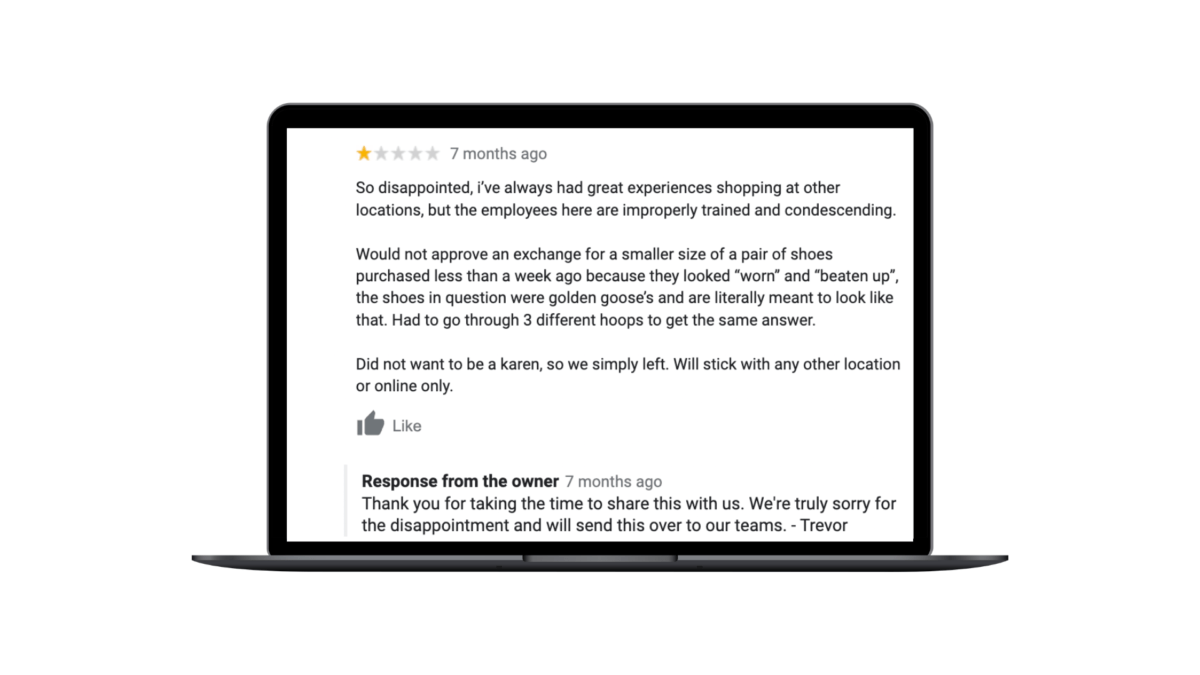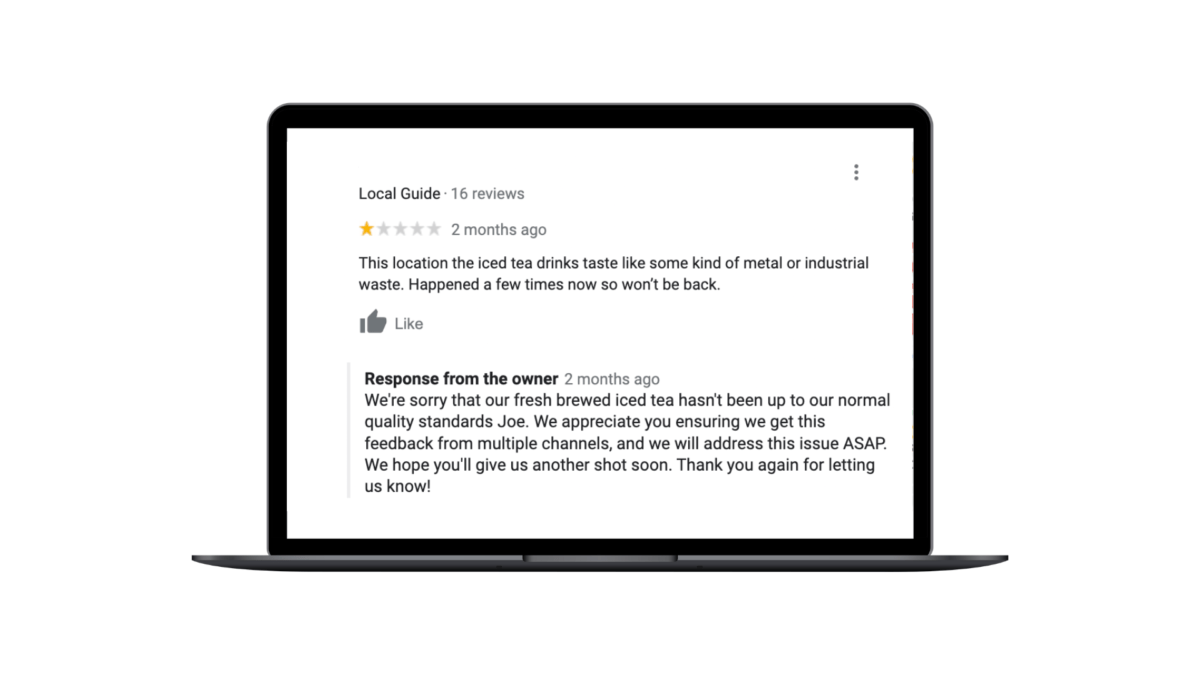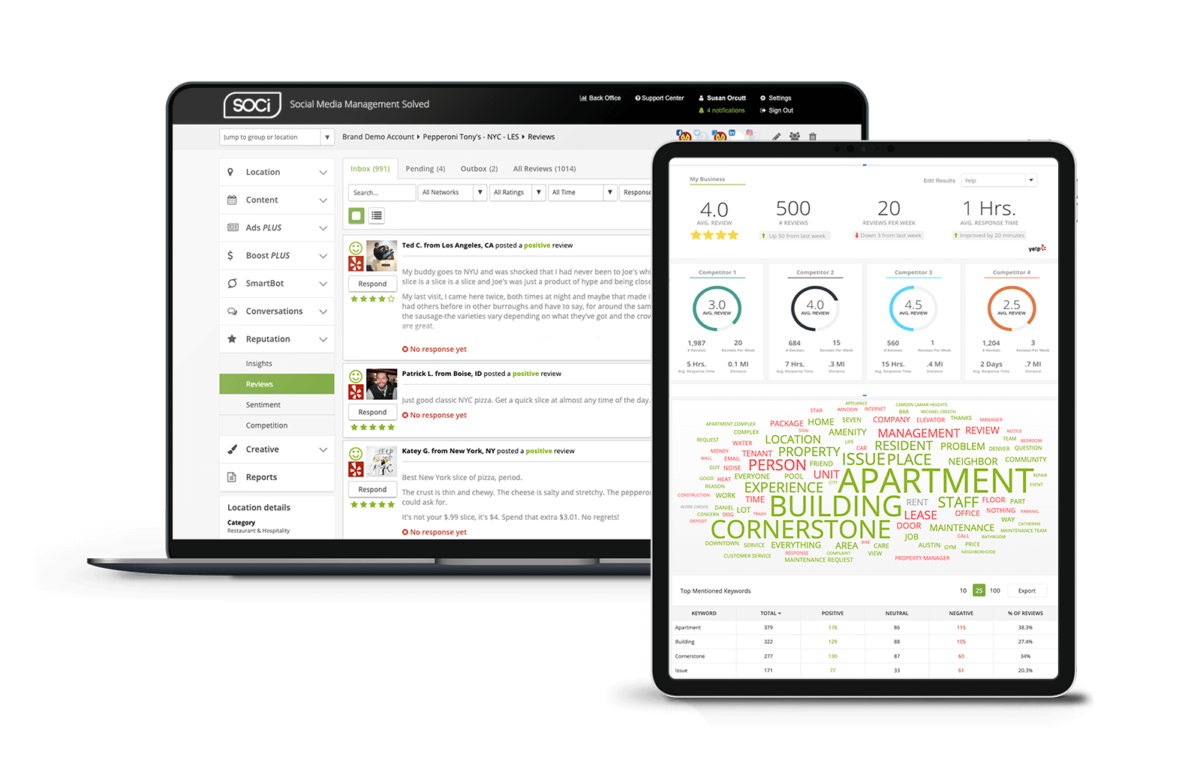Generative Engine Optimization (GEO): Mastering AI-Driven Search in 2025
How to Respond to Negative Reviews on Google
How to Respond to Negative Reviews on Google
As a multi-location marketer, receiving a negative review, especially a negative Google review, from a customer is likely never something you look forward to, but it happens! Rather than getting discouraged when your business receives a negative review, think of it as an opportunity.
Eighty-seven percent of those that leave reviews express a willingness to change it depending on how the business responds. The data speaks for itself. Review response, especially to negative reviews, is an essential component of a successful localized marketing strategy.
This blog will detail how to respond to negative reviews on Google and provide examples of review responses your business can mimic in the future. Let’s get started!
How Online Reviews on Google Can Impact Your Business
Ninety-eight percent of consumers feel that reviews are an essential resource when making a purchase decision. While reviews are a must, so is responding to them. SOCi’s research found that for every 25 percent of reviews responded to, the conversion of Google profiles improved by 4.1 percent.
Furthermore, consumers are more likely to choose a business with more reviews. For every 10 new reviews earned, conversion on Google Profiles improves by 2.8 percent. So it’s important to encourage customers to write reviews.
Online reviews can impact your business’s bottom line. For this piece, we’re going to focus on reviews on Google. Google is a leader in local search, with approximately 93 percent of the online search market share. As a multi-location business, focusing on reviews left on Google is non-negotiable.
Tips for Responding to Negative Reviews on Google
When one of your business locations receives a negative review on Google, don’t get too emotionally tied up! Before responding to a negative review, consider the following tips.
1. Don’t Take the Review Personally
The first thing to remember when responding to a negative review is that the review isn’t personal. The negative review is based on the customer’s experience and how they were feeling that day. Someone may have just been having a bad day when they interacted with your business.
That said, you should take the review at face value and always consider that the customer’s experience may have genuinely been negative.
If you see a review you disagree with or are frustrated with, pause before responding.
2. Respond In a Timely Manner
When responding to reviews, negative reviews should come first. Forty percent of consumers expect a response up to 24 hours after a negative review is posted. The sooner you can respond to negative reviews, the better.
As a multi-location business, it’s crucial to determine who is responsible for monitoring and responding to reviews. Is it up to each business location to monitor and respond to their reviews? How does corporate oversight come into play? If your multi-location business still needs to determine the answers to these questions, make a plan before responding to reviews.
3. Keep Your Response Professional
As you’d expect, keeping review responses professional and personalized is of utmost importance. When responding to a negative review, it’s essential to use the reviewer’s name in the response, thank them for taking the time to leave a review, and acknowledge their experience.
While showing empathy and understanding is necessary, avoid using too much emotion. To remain professional, recognize what the customer has said and focus on what your business can do better.
4. Acknowledge The Customer’s Experience
Often, a customer leaves a negative review because they want you to hear them. As mentioned, acknowledging the customer’s experience at face value is critical.
Address the customer’s negative experience as they’ve detailed it, and apologize for the incident or issues. It’s always better to accept and acknowledge the customer’s experience than try to minimize it or make excuses.
5. Offer a Resolution if Appropriate
Sometimes, your business needs to offer a resolution when addressing a negative review. For instance, if you’re a restaurant, and a diner complains about your restaurant’s wait time, point them to your online waitlist or suggest booking a reservation via your reservation system.
Similarly, there will be times when your business should offer a discount or incentive to appease a customer that had a negative experience. If that’s the case, take the conversation offline to avoid additional customers leaving a negative review with the hopes of receiving an incentive.
6. Make Note of Recurring Themes
Lastly, your business needs to track the feedback received from negative reviews. For instance, if you’re a retail brand and getting a lot of feedback about your customer service, what will you do to improve this? Similarly, if you’re a restaurant brand and you’ve received multiple complaints about food coming out cold, how can you fix this?
While responding to reviews is necessary, leveraging opportunities where your business can improve is just as important. This starts with determining how your business will track consumer pain points and, when the time comes, make adjustments accordingly.
For additional tips on responding to reviews and managing your online reputation, download our Multi-Location Marketer’s Guide to Online Reputation Management!
Examples of Responses to Negative Reviews
Following the tactics above will help your business craft appropriate responses to negative reviews. Next, let’s look at some examples! Below, you’ll find different situations in which your business may find itself and ways to respond.
It’s worth noting that these are just examples and should not be used as verbatim responses. Depending on the review and your business, the response will need to be adjusted accordingly.
We included an example of a business responding to a review that fits the situation in each section. The names of the business and reviewers featured are hidden.
The Customer Received Poor Customer Service From an Employee
If a customer leaves a review about the service they received at your business, it’s typically best to offer a general apology without getting into specifics. Although you may feel compelled to defend your staff, making the customer feel heard is essential.
Here’s an example:
“Hello [Reviewer Name]! We’re so glad you took the time to share your experience. We always aim for the absolute best in customer service, and we’re sorry you didn’t receive that. We assure you that you won’t see the same issues repeated if you return. Have a great day!”.
If you’re assuring the customer that they’ll have a better experience the next time, it’s critical to address any customer service issues that may be taking place at your business. Keep employees accountable for delivering a positive customer experience.
In the example below, the business thanked the reviewer for taking the time to leave the review while apologizing for their experience. Remember, if you say you’re going to take the feedback seriously, you must implement changes to avoid another customer having a parallel experience and leaving a similar review.

The Complaint is Related To a Specific Product or Service
Often, negative reviews will be related to a product or service at your business. When this happens, it’s essential to take the feedback at face value and, as mentioned earlier, make a note of recurring themes.
If you get multiple reviews commenting on the quality of a specific item your business sells, it may be time to reconsider selling it or work to improve it.
Here’s an example of a review response when this situation occurs:
“Dear [Reviewer Name], thank you for choosing us. We’re sorry that [the specific product or service] didn’t meet your expectations. We take feedback like yours very seriously and will do our best to improve. We hope you’ll give us another try!”
In the example below, the owner does a great job of using all of the tactics we’ve mentioned and implemented them into their response.

Your Business Receives a Complaint For Something Outside Its Control
Sometimes, your business receives a negative review for something you can’t directly control. For instance, if you’re a retail brand, you may get a complaint about the parking situation near your business.
In this case, you can respond with sympathy and offer the customer options that might suit them better:
“Hello [Reviewer Name]! Thanks so much for coming in. We’re sorry the parking situation was difficult. It can get that way sometimes on a Saturday afternoon! If you’d like to stop by when we’re less busy, we’re open from 10 am until 8 pm CST Monday-Friday! We also have parking on [street name], which is often available when the parking lot is full!”
While the business featured below may have been extra busy or understaffed on a Saturday, they did take the time to acknowledge the reviewer’s concerns and point them to someone who may offer them an incentive for their negative experience.

The Review Contains Content That is Fake or Inflammatory
Lastly, you may run into reviews that contain fake content or are inflammatory. While platforms like Google have a filter to catch these reviews before they’re published, a few might slip through the cracks. If so, Google has a process your business can use to flag and remove the review.
When this happens, the review is not worth responding to. You want to avoid drawing extra attention to it, and hopefully, Google will promptly remove the review.
Start Boosting Your Business’ Online Reputation
Now that you understand how to respond to negative reviews on Google, it’s time to start. As a multi-location business, monitoring and responding to reviews across 100s to 1,000s of business locations is challenging. That’s where SOCi comes in.
SOCi Reviews can help your business increase customer satisfaction and attract new leads by empowering local users with a tool to create personalized responses efficiently. Through SOCi, users can view every action taken on reviews and monitor every activity on social media.

Your local, regional, and corporate teams will always know which reviews and social engagements are addressed and which still require attention to ensure the prompt responses consumers expect. There’s no longer an excuse for letting review responses fall flat. For more insight into how SOCi can help you respond to negative reviews on Google and beyond, request a demo today!







